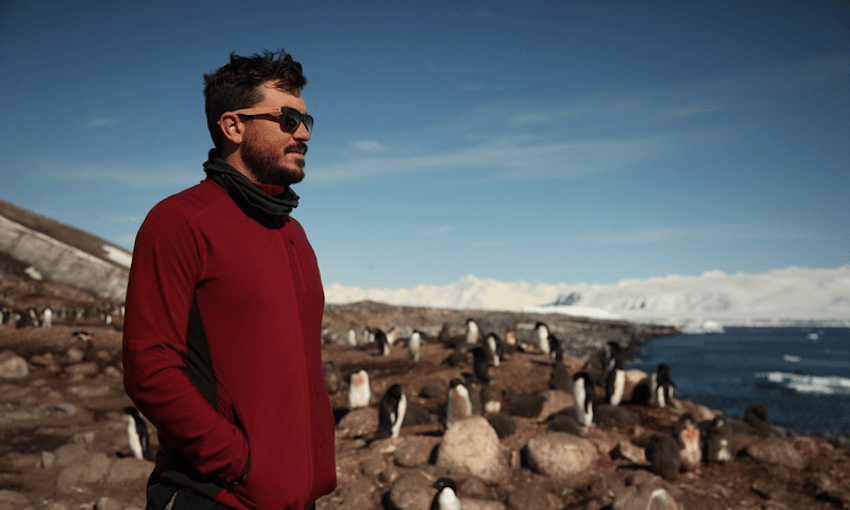Tara Ward talks to Spencer Stoner, the producer of Go Further South, the slow TV sensation that hits our screens this Easter.
Let’s change Good Friday’s name to “Great Friday”, or maybe “Even Better Friday”, because Prime is giving us the television tonic every lockdown needs. Go Further South, the slow-TV sequel to 2019’s Go South, lands softly and quietly on our screens tomorrow, taking us on an epic 12-hour journey deep into the Southern Ocean, past the subantarctic islands and along the Ross Sea coast, finishing at Scott Base in Antarctica.
That’s right. This weekend, we’re all going to Antarctica.
We bloody loved Go South – a gloriously relaxed train, boat and car journey through some of New Zealand’s most scenic landscapes – when it screened last year. “I’ve never worked on a show where I’ve gotten that level of feedback and enthusiasm from people before,” says Go Further South producer Spencer Stoner. It was only a matter of time until we got another pick at the slow TV grazing platter of life, and this time Spencer’s team has upped the stakes by sailing all the way to Antarctica, a place most New Zealanders won’t ever have the good fortune to visit.
“We didn’t want to rehash Go South and do a similar trip, treading through the same places,” Spencer says. “We thought, how can we build on this idea, but still focus on interesting New Zealand stories? What if we show them something completely different that they’ve never seen before?”
They teamed up with Heritage Expeditions, a Christchurch-based cruise company that ventures to the remotest parts of the Southern Ocean. While much of Go Further South’s journey is spent at sea, the trip also includes visits to several subantarctic islands, like Macquarie Island and Franklin Island, home to one of the world’s oldest penguin colonies.
“Being there was like nothing else I’ve seen on Earth,” Spencer says. “New Zealand was instrumental in having the Ross Sea protected as an international marine protected area, and it’s incredible sailing through there. You see a crazy amount of penguins, crazy amounts of orca, all sorts of wildlife. It’s like travelling through an alien planet.”
It might seem weird to dedicate an entire day to a show where nothing much happens, but that’s the beauty of slow-TV. There are no commercial breaks or interrupting voiceovers, just 12 soothing hours of stunning landscapes and incredible wildlife. Go Further South is the perfect show to sink into during a national lockdown, a restoring balm to remind you that even though things are a bit stink right now, the world is still filled with beautiful and astonishing wonders.
“The advantage of being in lockdown is that you can have Go Further South playing while you’re going about your day to day life in your house,” Spencer reckons. “You can check-in and out of the show, and get the full experience in the way it’s meant to be watched.
“There are chunks of time when we’re just at sea, appreciating the different phases and characteristics of the Southern Ocean. There are also times where, in classic slow-TV fashion, you can let the camera linger on a shot for minutes at a time,” Spencer says. This is which is where the hypnotic, calming power of slow-TV takes hold. “People have the opportunity to visually explore the landscape, without having a story shoved in their face.”
Making Go Further South proved a bigger challenge than Go South, thanks to the fierce unpredictability of the Southern Ocean. The crew operated cameras from a central control room on the ship, which allowed them to capture every important moment of the journey despite the 13 metre swells, overwhelming sea-sickness and freezing temperatures. A special rig was attached to the top of the ship to stabilise the main camera, which removed the shake from the waves and let the crew zoom in at close range of all the action at sea.
“I can say that the rumours about how rough the Southern Ocean is are totally warranted,” Spencer says. “I would wake up in the middle of the night because my head was slamming into the wall. We were told we had good conditions, but they were very rough.” It wasn’t Spencer’s only dicey moment. He fell into a lagoon while visiting Franklin Island, and with hours of footage still to film, he had no choice but to take a cleansing dip in the sea. “It was one of those moments when you’re washing yourself in water that’s basically zero degrees, wondering how you got there.”
Slow TV may have originated in Scandinavia, but Spencer reckons New Zealand has embraced the trend and made it our own. “I think we’ve reinvented the genre of slow TV a little bit, into something which suits our unique situation. We’re surrounded by incredibly diverse landscapes with interesting histories and things are constantly changing,” he says. “What’s cool about New Zealand slow TV is that the pace is slow, but you don’t have to wait long to see something completely different from what you’ve been looking at.”
What’s the next journey in the slow-TV landscape for Spencer and his team? “We keep joking that the next one will be Go North, and it will just be a three-week cruise around Fiji,” Spencer says. Sounds perfect.
Go Further South screens on Prime on Good Friday, the 10th of April, from 7:30am. You can watch a three-hour version of the original Go South from 7:15pm on Easter Sunday, the 12th of April, also on Prime.
